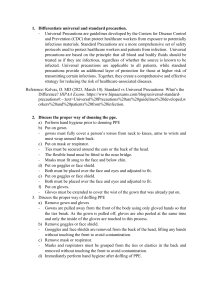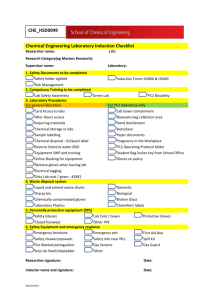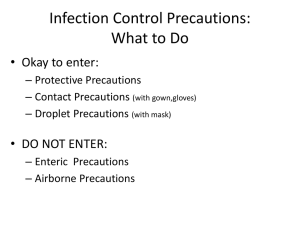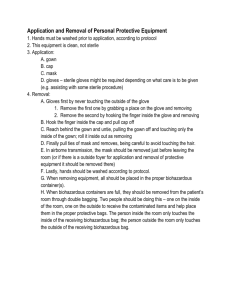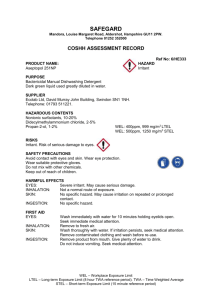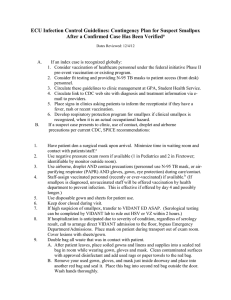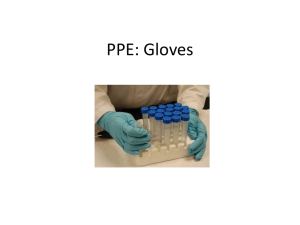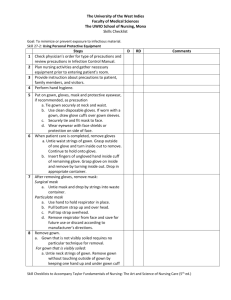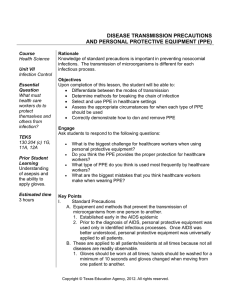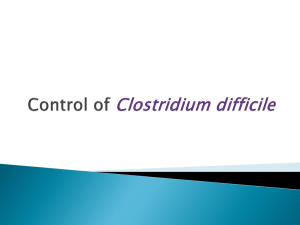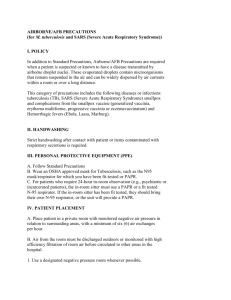Disease Transmission Precautions and PPE Notes Sheet
advertisement
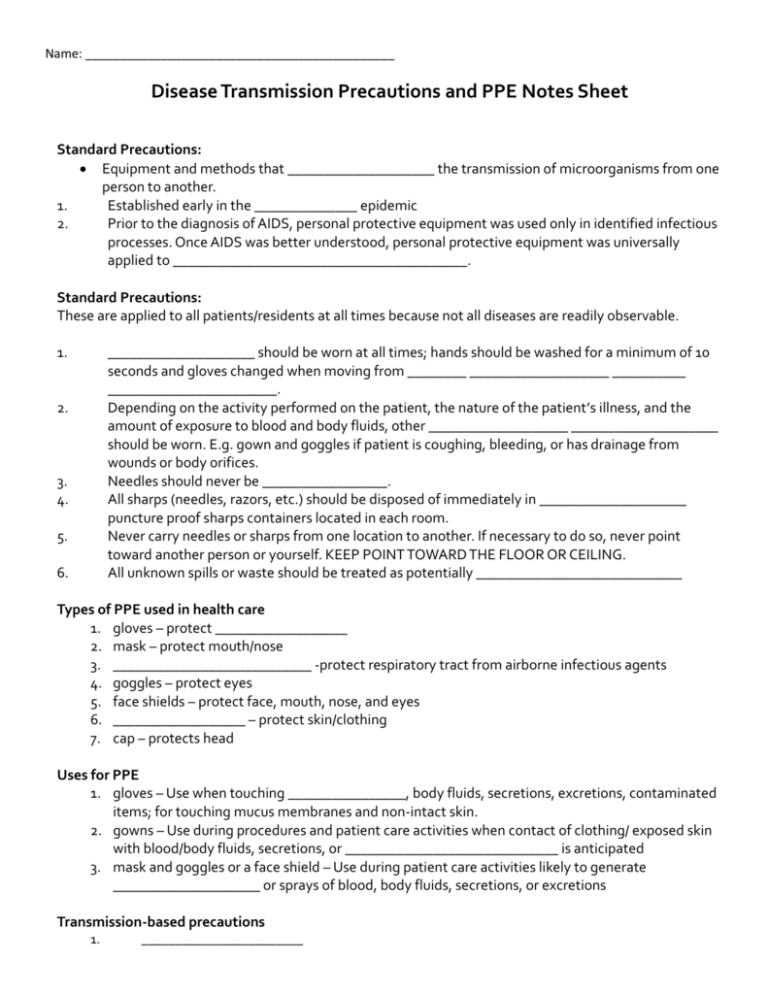
Name: _____________________________________________ Disease Transmission Precautions and PPE Notes Sheet Standard Precautions: Equipment and methods that ____________________ the transmission of microorganisms from one person to another. 1. Established early in the ______________ epidemic 2. Prior to the diagnosis of AIDS, personal protective equipment was used only in identified infectious processes. Once AIDS was better understood, personal protective equipment was universally applied to ________________________________________. Standard Precautions: These are applied to all patients/residents at all times because not all diseases are readily observable. 1. ____________________ should be worn at all times; hands should be washed for a minimum of 10 seconds and gloves changed when moving from ________ ___________________ __________ _______________________. Depending on the activity performed on the patient, the nature of the patient’s illness, and the amount of exposure to blood and body fluids, other ___________________ ____________________ should be worn. E.g. gown and goggles if patient is coughing, bleeding, or has drainage from wounds or body orifices. Needles should never be _________________. All sharps (needles, razors, etc.) should be disposed of immediately in ____________________ puncture proof sharps containers located in each room. Never carry needles or sharps from one location to another. If necessary to do so, never point toward another person or yourself. KEEP POINT TOWARD THE FLOOR OR CEILING. All unknown spills or waste should be treated as potentially ____________________________ 2. 3. 4. 5. 6. Types of PPE used in health care 1. gloves – protect __________________ 2. mask – protect mouth/nose 3. ___________________________ -protect respiratory tract from airborne infectious agents 4. goggles – protect eyes 5. face shields – protect face, mouth, nose, and eyes 6. __________________ – protect skin/clothing 7. cap – protects head Uses for PPE 1. gloves – Use when touching ________________, body fluids, secretions, excretions, contaminated items; for touching mucus membranes and non-intact skin. 2. gowns – Use during procedures and patient care activities when contact of clothing/ exposed skin with blood/body fluids, secretions, or _____________________________ is anticipated 3. mask and goggles or a face shield – Use during patient care activities likely to generate ____________________ or sprays of blood, body fluids, secretions, or excretions Transmission-based precautions 1. ________________________ Name: _____________________________________________ 2. 3. 4. a. Diseases that are spread through the air b. Examples include chickenpox, measles, TB Droplet a. Diseased spread by droplets, as in a ________________________ or cough b. Examples include certain types of meningitis and pneumonia, pertussis, influenza, mumps, German Measles Contact a. Examples include _____________________, impetigo, diphtheria, scabies, AIDS, MRSA b. Disease spread by contact with infected skin or objects Reverse or Protective Isolation a. this concept is the opposite of every other transmission-based precaution b. it involves protecting the __________________________/________________________ from any infectious process carried by the health care providers or the public c. necessary for patients with immune ______________________/_________________________ immune systems: i.e. AIDS patients, transplant patients, cancer chemotherapy patients How airborne precautions work 1. patient’s room must be private unless both patients have the same _____________________ 2. room may have special ventilation equipment 3. the door of the room must remain ______________________ 4. staff and visitors must wear masks 5. if staff has more direct prolonged contact with the patient, it is advisable to wear gloves, gown, hair covering, depending on the activity 6. patients should leave the room as _____________________ as possible and wear a mask if they do leave How droplet precautions work 1. similar to airborne, but droplet travels no more than ___________________ ___________________ 2. therefore room should be private or people with same diseases 3. if patients with different diseases are placed in the same room, they should be separated by at least three feet 4. staff and visitors within three feet of patient need to _______________ __________________________ 5. if staff has more direct ________________________ contact with the patient, it is advisable to wear gloves, gown, hair covering, goggles, depending on the activity 6. patients should leave room as little as possible and wear masks when they leave How contact precautions work 1. May be private or have people with same diseases together 2. Everyone entering the room must wear __________________ and change them whenever soiled 3. Gowns, mask, goggles, hair covering, should be worn depending on length of contact and activity 4. All must wash their hands and avoid touching objects before _____________________ the room 5. Patients should leave the room as little as possible and avoid contact with other people or objects 6. Use _________________________ waste bags to dispose of any trash or items leaving the room 7. Equipment such as thermometer, blood pressure equipment should remain __________ ____________ ________________, and disinfected properly when precautions have been discontinued Name: _____________________________________________ Reverse isolation a. The health care provider puts on any necessary equipment to prevent exposing the compromised ____________________ to any microorganisms b. The _________________________ is determined by the care that is to be given Exposure • • • • Should a known exposure occur to a microorganism, i.e. HIV, the exposure must be reported to the _______________________ of the unit. An incident report must be completed. Depending on the exposure, the area should be cleaned with an antiseptic solution, and if necessary, appropriate __________________ __________________ should be completed. Follow-up must be done as required by _______________ (either facility or CDC). Application of PPE A. Hands must be washed ________________ to application according to protocol B. This equipment is clean, not sterile C. Order of application 1. 2. 3. 4. ___________________ cap _______________________ gloves – sterile gloves might be required depending on what care is to be given (e.g. assisting with some sterile procedure) Order of Removal 1. Gloves ________________ by never touching the outside of the glove a. remove the first one by grabbing a place on the glove and removing b. remove the second by hooking the finger inside the glove and removing 2. Hook the finger inside the ____________ and pull cap off 3. Reach behind the gown and untie, pulling the gown off and touching only the inside of the gown; roll it ______________________ out as removing 4. Finally pull ties of mask and removes, being careful to avoid touching the _________________. 5. In airborne transmission, the mask should be removed just before ____________________ the room (or if there is a outside foyer for application and removal of protective equipment it should be removed there) 6. Lastly, hands should be ______________________ according to protocol. 7. When removing equipment, all should be placed in the proper _____________________ container(s). 8. When biohazard containers are full, they should be removed from the patient’s room through ____________________________ _______________________________.

